Download
Q.1 The dimension of ![]() are :
are :
(1) ![]()
(2) ![]()
(3) ![]()
(4) ![]()
Q.2 The moment of inertia of a thin uniform rod of mass M and length L about an axis passing through its midpoint and perpendicular to its length is I0. Its moment of inertia about an axis passing through one of its ends and perpendicular to its length is :
(1) ![]()
(2) ![]()
(3) ![]()
(4) ![]()
Q.3 A boy standing at the top of a tower of 20 m height drops a stone. Assuming g = 10 ms–2, the velocity with which it hits the ground is :
(1) 5.0 m/s
(2) 10.0 m/s
(3) 20.0 m/s
(4) 40.0 m/s
Q.4 A person of mass 60 kg is inside a lift of mass 940 kg and presses the button on control panel. The lift starts moving upwards with an acceleration 1.0 m/s2. If g = 10 ms–2, the tension in the supporting cable is :
(1) 1200 N
(2) 8600 N
(3) 9680 N
(4) 11000 N
Q.5 A body projected vertically from the earth reaches a height equal to earth’s radius before returning to the earth. The power exerted by the gravitational force is greatest :
(1) at the instant just after the body is projected.
(2) at the highest position of the body
(3) at the instant just before the body hits the earth.
(4) it remains constant all through.
Q.6 The instantaneous angular position of a point on a rotating wheel is given by the equation θ (t) = 2t3 – 6t2
The torque on the wheel becomes zero at :
(1) t = 2 s
(2) t = 1 s
(3) t = 0.5 s
(4) t = 0.25 s
Q.7 A particle moves in a circle of radius 5 cm with constant speed and time period 0.2 π s. The acceleration of the particle is :
(1) 5 m/s2 (2) 15 m/s2
(3) 25 m/s2 (4) 36 m/s2
Q.8 A body of mass M hits normally a rigid wall with velocity V and bounces back with the same velocity. The impulse experienced by the body is –
(1) Zero
(2) MV
(3) 1.5 MV
(4) 2 MV
Q.9 A planet moving along an elliptical orbit is closest to the sun at a distance r1 and farthest away at a distance of r2. If v1 and v2 are the linear velocities at these points respectively, then the ratio ![]() is :
is :
(1) ![]()
(2) ![]()
(3) ![]()
(4) ![]()
Q.10 A radioactive nucleus of mass M emits a photon of frequency ν and the nucleus recoils. The recoil energy will be –
(1) hν
(2) Me2–hν
(3) ![]()
(4) Zero
Q.11 The potential energy of a system increases if work is done :
(1) Upon the system by a conservative force.
(2) Upon the system by a nonconservative force.
(3) by the system against a conservative force.
(4) by the system against a nonconservative force
Q.12 A body is moving with velocity 30 m/s towards east. After 10 seconds its velocity becomes 40 m/s towards north. The average acceleration of the body is :
(1) 5 m/s2
(2) 1 m/s2
(3) 7 m/s2
(4) 7 m/s2
Q.13 A missile is fired for maximum range with an initial velocity of 20 m/s. If g = 10 m/s2, the range of the missile is :
(1) 20 m
(2) 40 m
(3) 50 m
(4) 60 m
Q.14 Force F on a particle moving in a straight line varies with distance d as shown in the figure. The work done on the particle during its displacement of 12 m is :

(1) 13 J
(2) 18 J
(3) 21 J
(4) 26 J
Q.15 A charge Q is enclosed by a Gaussian spherical surface of radius R. If the radius is doubled, then the outward electric flux will :
(1) be doubled
(2) increase four time
(3) be reduced to half
(4) remain the same
Q.16 Four electric charge + q, + q, – q and – q are placed at the corners of a square of side 2L. (see figure). The electric potential at point A, midway between the two charge + q and + q, is :
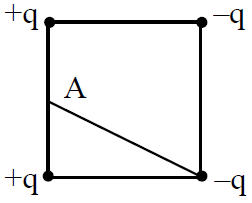
(1) Zero
(2) ![]()
(3) ![]()
(4) ![]()
Q.17 A parallel plate condenser has a uniform electric field E (V/m) in the space between the plates. If the distance between the plates is d (m) and area of each plate is A (m2) the energy (joules) stored in the condenser is :
(1) ![]()
(2) ![]()
(3) ![]()
(4) ![]()
Q.18 If power dissipated in the 9Ω resistor in the circuit shown is 36 Watt, the potential difference across the 2 Ω resistor is :
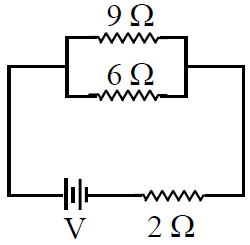
(1) 2 Volt
(2) 4 Volt
(3) 8 Volt
(4) 10 Volt
Q.19 A current of 2 A flows through a 2 Ω resistor when connected across a battery. The same battery supplies a current of 0.5 A when connected across a 9 Ω resistor. The internal resistance of the battery is :
(1) 1 Ω
(2) 0.5 Ω
(3) 1/3 Ω
(4) 1/4 Ω
Q.20 The rate of increase of thermo-e.m.f. with temperature at the neutral temperature of a thermocouple :
(1) is negative
(2) is positive
(3) is zero
(4) depends upon the choice of the two materials of the thermocouple.
Q.21 A current carrying closed loop in the form of a right angle isosceles triangle ABC is placed in a uniform magnetic field acting along AB. If the magnetic force on the arm BC is ![]() , the force on the arm AC is :
, the force on the arm AC is :

(1) ![]()
(2) ![]()
(3) ![]()
(4) ![]()
Q.22 The power obtained in a reactor using U235 disintegration is 1000 kW. The mass decay of U235 per hour is :
(1) 1 microgram
(2) 10 microgram
(3) 20 microgram
(4) 40 microgram
4
Q.23 There are four light-weight-rod samples A,B,C, D separately suspended by threads. A bar magnet is slowly brought near each sample and the following observations are noted :
(a) A is feebly repelled
(b) B is feebly attracted
(c) C is strongly attracted
(d) D remains unaffected
Which one of the following is true ?
(1) A is of a non-magnetic material
(2) B is of a paramagnetic material
(3) C is of a diamagnetic material
(4) D is of a ferromagnetic material
2
Q.24 The electric and the magnetic field, associated with an e.m. wave, propagating along the +z axis, can be represented by :
(1) ![]()
(2) ![]()
(3) ] ![]()
(4) ![]()
2
Q.25 A uniform electric field and a uniform magnetic field are acting along the same direction in a certain region. If an electron is projected in the region such that its velocity is pointed along the direction of fields, then the electron :
(1) will turn towards left of direction of motion
(2) will turn towards right of direction of motion
(3) speed will decrease
(4) speed will increase
3
Q.26 The current i in a coil varies with time as shown in the figure. The variation of induced emf with time would be :
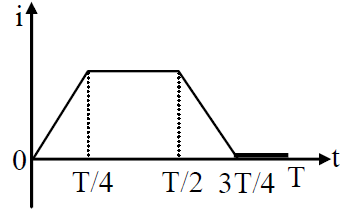
(1) 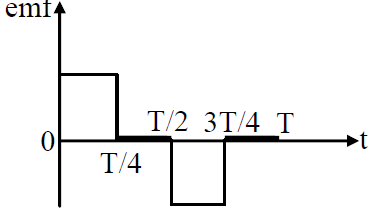
(2) 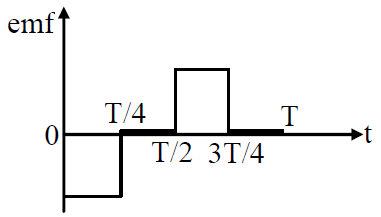
(3) 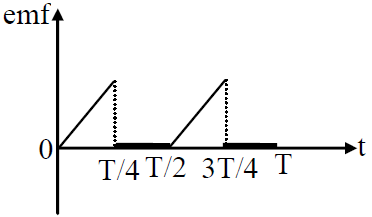
(4) 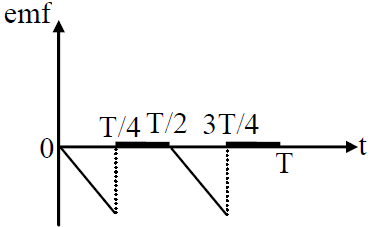
2
Q.27 In an ac circuit an alternating voltage ![]() sin 100 t volts is connected to a capacitor of capacity 1 μF. The r.m.s. value of the current in the circuit is :
sin 100 t volts is connected to a capacitor of capacity 1 μF. The r.m.s. value of the current in the circuit is :
(1) 20 mA
(2) 10 mA
(3) 100 mA
(4) 200 mA
1
Q.28 An ac voltage is applied to a resistance R and an inductor L in series. If R and the inductive reactance are both equal to 3Ω, the phase difference between the applied voltage and the current in the circuit is :
(1) zero
(2) π/6
(3) π/4
(4) π/2
3
Q.29 When 1 kg of ice at 0ºC melts to water at 0ºC, the resulting change in its entropy, taking latent heat of ice to be 80 Cal/gm, is :
(1) 293 Cal /K
(2) 273 Cal/K
(3) 8 × 104 Cal/K
(4) 80 Cal/K
1
Q.30 During an isothermal expansion, a confined ideal gas does – 150 J of work against its surroundings. This implies that :
(1) 150 J of heat has been added to the gas
(2) 150 J of heat has been removed from the gas
(3) 300 J of heat has been added to the gas
(4) no heat is transferred because the process is isothermal.
1
Q.31 A particle of mass m is released from rest and follows a parabolic path as shown. Assuming that the displacement of the mass from the origin is small which graph correctly depicts the position of the particles as a function of time ?
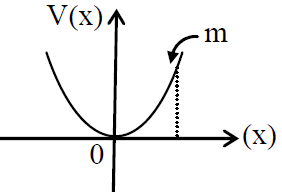
(1) 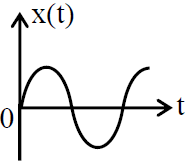
(2) 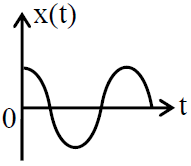
(3) 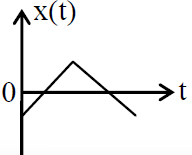
(4) 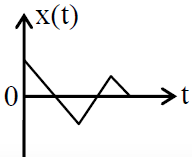
2
Q.32 Two waves are represented by the equations y1 = a sin (ωt + kx + 0.57) m and y = a cos (ωt + kx)m, where x is in meter and t in sec. The phase difference between them is :
(1) 0.57 radian
(2) 1 radian
(3) 1.25 radian
(4) 1.57 radian
2
Q.33 Out of the following functions representing motion of a particle which represents SHM :
(A) y = sin ωt – cos ωt
(B) y = sin3 ωt
(C) ![]()
(D) y = 1 + ωt + ω2t2
(1) Only (A) and (B)
(2) Only (A)
(3) Only (D) does not represent SHM
(4) Only (A) and (C)
4
Q.34 Sound waves travel at 350 m/s through a warm air and at 3500 m/s through brass. The wavelength of a 700 Hz acoustic wave as it enters brass from warm air :
(1) decreases by a factor 20
(2) decreases by a factor 10
(3) increases by a factor 20
(4) increases by a factor 10
4
Q.35 The decreasing order of wavelength of infrared, microwave, ultraviolet and gamma rays is :
(1) infrared, microwave, ultraviolet, gamma rays
(2) microwave, infrared, ultraviolet, gamma rays
(3) gamma rays, ultraviolet, infrared, microwaves
(4) microwaves, gamma rays, infrared, ultraviolet
2
Q.36 The wavelength of the first line of Lyman series for hydrogen atom is equal to that of the second line of Balmer series for a hydrogen like ion. The atomic number Z of hydrogen like ion is :
(1) 2
(2) 3
(3) 4
(4) 1
1
Q.37 Which of the following is not due to total internal reflection ?
(1) brilliance of diamond
(2) working of optical fibre
(3) difference between apparent and real depth of a pond
(4) mirage on hot summer days
3
Q.38 A biconvex lens has a radius of curvature of magnitude 20 cm. Which one of the following options describe best the image formed of an object of height 2 cm placed 30 cm from the lens ?
(1) Real, inverted, height = 1 cm
(2) Virtual, upright, height = 1 cm
(3) Virtual, upright, height = 0.5 cm
(4) Real, inverted, height = 4 cm
4
Q.39 In photoelectric emission process from a metal of work function 1.8 eV, the kinetic energy of most energetic electrons is 0.5 eV. The corresponding stopping potential is :
(1) 2.3 V
(2) 1.8 V
(3) 1.3 V
(4) 0.5 V
4
Q.40 Electrons used in an electron microscope are accelerated by a voltage of 25 kV. If the voltage is increased to 100 kV then the de-Broglie wavelength associated with the electrons would
(1) increase by 4 times
(2) increase by 2 times
(3) decrease by 2 times
(4) decrease by 4 times
3
Q.41 Light of two different frequencies whose photons have energies 1 eV and 2.5 eV respectively illuminate a metallic surface whose work function is 0.5 eV successively. Ratio of maximum speeds of emitted electrons will be :
(1) 1 : 5
(2) 1 : 4
(3) 1 : 2
(4) 1 : 1
3
Q.42 In the Davisson and Germer experiment, the velocity of electrons emitted from the electron gun can be increased by :
(1) decreasing the potential difference between the anode and filament
(2) increasing the potential difference between the anode and filament
(3) increasing the filament current
(4) decreasing the filament current
2
Q.43 The half life of radioactive isotope ‘X’ is 50 years. It decays to another element ‘Y’ which is stable. The two elements ‘X’ and ‘Y’ were found to be in the ratio of 1 : 15 in a sample of a given rock. The age of the rock was estimated to
be :
(1) 100 years
(2) 150 years
(3) 200 years
(4) 250 years
3
Q.44 Photoelectric emission occurs only when the incident light has more than a certain minimum:
(1) frequency
(2) power
(3) wavelength
(4) intensity
1
Q.45 Fusion reaction takes place at high temperature because :
(1) molecules break up at high temperature
(2) nuclei break up at high temperature
(3) atomic get ionised at high temperature
(4) kinetic energy is high enough to overcome the coulomb repulsion between nuclei
4
Q.46 A nucleus ![]() emits one α–particle and two
emits one α–particle and two
β–particles. The resulting nucleus is :
(1) ![]()
(2) ![]()
(3) ![]()
(4) ![]()
4
Q.47 A transistor is operated in common emitter configuration at VC = 2V such that a change in the base current from 100 μA to 300 μA produces a change in the collector current from 10 mA to 20 mA. The current gain is :
(1) 25
(2) 50
(3) 75
(4) 100
2
Q.48 If a small amount of antimony is added to germanium crystal :
(1) its resistance is increased
(2) it becomes a p-type semiconductor
(3) the antimony becomes an acceptor atom
(4) there will be more free electrons than holes in the semiconductor
4
Q.49 In forward biasing of the p-n junction :
(1) the positive terminal of the battery is connected to p-side and the depletion region becomes thin
(2) the positive terminal of the battery is connected to p-side and the depletion region becomes thick
(3) the positive terminal of the battery is connected to n-side and the depletion region becomes thin
(4) the positive terminal of the battery is connected to n-side and the depletion region becomes thick.
1
Q.50 Symbolic representation of four logic gates are shown as :
(i) 
(ii) 
(iii) 
(iv) 
Pick out which ones are for AND, NAND and NOT gates, respectively :
(1) (ii), (iv) and (iii)
(2) (ii), (iii) and (iv)
(3) (iii), (ii) and (i)
(4) (iii), (ii) and (iv)
1
